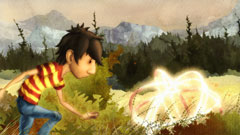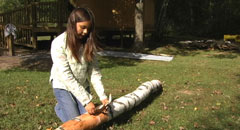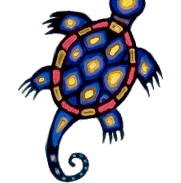There is always time for rebirth
JUNE 12 TO 22, NFB - CINÉMATHÈQUE QUÉBÉCOISE
Films and videos are blazing First Nations’ path to recognition. First Peoples’ Festival is a witness to and participant in this thrilling process.
In a few flashes of light, an overview of the 2008 program schedule.
Who can belong to this very select club? Only those with the proper blood cocktail, preferably not watered down. Because we fear apples like the plague. Red on the surface, white inside—yecch! From the opening film the tone is set: Attention! Mischievous and caustic humour is the order of the day. Club Native addresses identity issues: more precisely the way fussbudget inspectors from the bloodpurity brigade measure identity with a heavy hand. Director Tracy Deer takes a lighter approach and deftly questions some Band Councils' deeply-ingrained attitudes, including the Council of her own community, Kahnawake.

Aboriginality
The quest for this mysterious Aboriginality (the title of a short, by the way) is decidedly in the air these days. From Sweden, a young director adds her own pieces of evidence to the identity file with Sami Daughter Yoik, while a Wendat woman turns a loving gaze towards her forefather the Grand Chief and his wisdom in Peu importe l'âge: Max et Anora. And we must be wary of clichés along the way: I am not the Indian you have in mind as Thomas King warns us.
This search for the authentic self can take the form of journeys back to your roots. The journey is nostalgic in Little Caughnawaga: to Brooklyn and Back de Regan Tarbell, a look at Mohawk high-steel workers and their families' lives in New York City, and tragic in A Sister's Love by Ivan Sen in which an Aborigine woman returns to the setting of the (unsolved) murder of her twin sister. It might be a journey to recover past lifeways, such as the forgotten crafts in Umiaq Skin Boat by Jobi Weetaluktuk and Basket Making by Cynthia Taylor. It could also take a spectacular turn, as in Kiviuk, when theatrical representation brings legends back to life, or a ceremonial form when the Wayuus rebury their dead, an ancient funerary rite shown in Jepirra paraiso de los Wayuus. Language remains a pillar of identity. Alarm bells are sounded as languages fade away, as in Kevin Papatie's L'Amendement. But some nations take action to keep their languages alive. For example, Mohawks who founded a school grounded in their language and culture, an achievement documented by Paul Rickard and Tracey Deer in Kanien'kehá:ka, Living the Language.

Kanien’kehá:ka, Living the Language
Ancestral lands are a cherished focus of identity in Henman W. Niquay's Kitaskino, and a focus of struggles in Mexico's Morelos State, 13 pueblos en defensa del agua, el aire y la tierra. Sometimes these lands will be lost forever when a dam is built on them, as in Le Crépuscule d'une terre, filmed in Cree country. Yet peoples will take action to defend their lands in the face of harsh colonial injustice meted out on the Mapuches in Chile in Considérant que...and the Shoshones in the USA in Our Land, Our Life.

Shooting Geronimo
All of these topics and even more are on the First Peoples' Festival 2008 roster. It will also feature surrealistic humour in the Miss Chief Eagle Testickle Trilogy (Shooting Geronimo, Group of Seven Inches, Robin’s Hood) by Gisèle Gordon and Kent Monkman, humour packing a punch in Nana, black and sarcastic comedy in Jeff Barnaby's The Colony, and rather naughty humour in Ting by Chanouk Newashish. And the festival pays homage to artists, in classical ballet in Water Flowing Together, the portrait of a Navajo dancer at the New York City Ballet; or writers such as Scott Momaday and Miguel Ángel Jusayú, depicted in the films L'Ours et Moi and El Niño Shuá. These artists may experience a tormented quest during the creative process such as Floyd Favel in The Tunguska Project or a struggle in all facets of life and art, as in Hiro, the portrait of a visionary Polynesian poet.
We also have the opportunity to view re-issued classics such as L'Histoire de Manawan (1972) et L’ilawat (1975), the very first works Alanis Obomsawin made as a young director when she started working with NFB, and Wapistan et les oiseaux d'été, at the inception of Diane and Daniel Bertolino's series Légendes amérindiennes.
Darkened cinemas shed more and more light on original peoples. First Peoples' Festival 2008 is a beacon in the development in an Aboriginal cinematography in the American lands.

